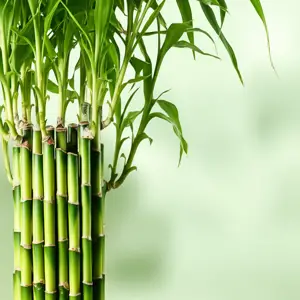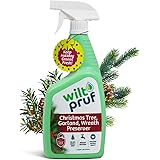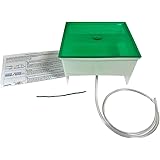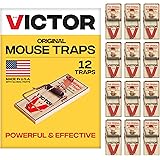Bamboo plants, with their graceful stalks and lush green foliage, bring a touch of tranquility and zen to any space. Whether you’ve got a lucky bamboo gracing your office desk or a larger bamboo variety adding privacy to your garden, seeing it struggle can be disheartening.
But don’t despair! Often, a “dying” bamboo plant can be revived with the right care and attention. This comprehensive guide, updated for 2025, will walk you through the common causes of bamboo decline and provide actionable steps to bring your plant back to its vibrant self.
Understanding the Signs of a Declining Bamboo Plant
Before you can implement a rescue plan, you need to accurately assess the situation. Recognizing the symptoms of a struggling bamboo plant is crucial for effective intervention.
Common Signs of a Sick Bamboo Plant
- Yellowing Leaves: This is perhaps the most common sign of distress. It can indicate overwatering, underwatering, nutrient deficiencies, or poor water quality.
- Brown Leaves: Brown tips or edges on leaves often suggest dry air, insufficient watering, or fertilizer burn.
- Stunted Growth: If your bamboo isn’t putting out new shoots or leaves, it might be lacking essential nutrients or facing root problems.
- Drooping Leaves: This can indicate either too much or too little water. It can also be a sign of root rot.
- Soft or Mushy Stalks: This is a serious sign of rot, usually caused by fungal infections due to overwatering or poor drainage.
- Discolored or Spotted Leaves: These could indicate a fungal infection or pest infestation.
- Slow or No Root Growth: Check the roots (carefully!) for signs of rot or being root-bound.
Distinguishing Between Different Types of Bamboo
It’s important to know which type of bamboo you have, as their care requirements can vary. Generally, bamboo plants fall into two categories:
- Lucky Bamboo (Dracaena sanderiana): Technically not bamboo, but a member of the Dracaena family. Often grown in water.
- True Bamboo (various species within the Bambusa, Phyllostachys, and other genera): These are the woody, grass-like bamboos that are grown in soil, indoors or outdoors.
The rest of this guide will address both types, but we’ll specify when the advice is specific to either Lucky Bamboo or true bamboo.
Identifying the Root Cause: Why is Your Bamboo Dying?
Once you’ve identified the symptoms, the next step is to diagnose the underlying cause. Bamboo plants are generally resilient, but they can be susceptible to certain environmental and care-related issues.

revive bamboo
Watering Issues: The Delicate Balance
Watering is often the primary culprit behind a struggling bamboo plant. Both overwatering and underwatering can lead to significant problems. According to a 2023 study by the University of Florida, optimal soil moisture for potted bamboo is between 50-70%.
Overwatering: The Silent Killer
Overwatering leads to root rot, a fungal infection that can quickly kill your bamboo. Signs of overwatering include:
- Yellowing leaves, especially starting from the bottom of the plant
- Drooping leaves
- Soft, mushy stalks, particularly near the base
- Foul odor coming from the soil or water
Read More: About How to Separate a Monstera: Easy Steps + Care Tips
Example: Sarah, a home decor enthusiast in Atlanta, noticed her lucky bamboo was turning yellow despite regular watering. Upon closer inspection, she realized the decorative pebbles in the vase were preventing proper aeration, leading to root rot. After removing the pebbles and changing the water more frequently, her bamboo recovered.
Underwatering: Parched and Suffering
Underwatering, while less common, can also stress your bamboo. Signs of underwatering include:
- Brown, crispy leaf tips and edges
- Dry, brittle stalks
- Stunted growth
- Soil pulling away from the sides of the pot
Example: David, a busy professional in Seattle, often forgot to water his indoor bamboo plant. He noticed the leaf tips were turning brown and the plant looked generally lackluster. By setting a watering reminder on his phone and using a self-watering globe, he was able to revive his bamboo.
Light Requirements: Finding the Sweet Spot
Bamboo plants need adequate light to thrive, but direct sunlight can scorch their leaves. The ideal light conditions vary depending on the species.
Insufficient Light: Pale and Leggy
If your bamboo isn’t getting enough light, it may exhibit the following symptoms:
- Pale green or yellowing leaves
- Leggy growth (long, thin stems with sparse leaves)
- Stunted growth
Too Much Direct Sunlight: Scorched and Stressed
Conversely, too much direct sunlight can burn the leaves and stress the plant. Signs of excessive sunlight include:
- Brown, scorched patches on leaves
- Faded leaf color
- Dry, brittle leaves
Nutrient Deficiencies: Feeding Your Bamboo
Bamboo plants need essential nutrients to grow and stay healthy. Nutrient deficiencies can manifest in various ways.
Identifying Nutrient Deficiencies
Common nutrient deficiencies in bamboo include:
- Nitrogen Deficiency: Yellowing of older leaves, starting from the tips and moving inward.
- Potassium Deficiency: Brown spots on leaves, particularly along the edges.
- Iron Deficiency: Yellowing between the veins of younger leaves (chlorosis).
Table: Common Nutrient Deficiencies in Bamboo
| Nutrient Deficiency | Symptoms |
|---|---|
| Nitrogen | Yellowing of older leaves |
| Potassium | Brown spots on leaves, especially edges |
| Iron | Yellowing between the veins of younger leaves |
Poor Water Quality: The Hidden Threat
Tap water can contain chlorine, fluoride, and other chemicals that can harm bamboo plants, especially Lucky Bamboo grown in water. Using distilled or filtered water is highly recommended.
Pest Infestations: Tiny Invaders
Although relatively pest-resistant, bamboo can be susceptible to certain pests, especially when stressed. Common pests include:
- Spider Mites: Tiny, spider-like mites that create webs on leaves and suck out plant juices, causing yellowing and spotting.
- Mealybugs: Small, white, cottony insects that cluster on stems and leaves, sucking out sap.
- Scale: Small, armored insects that attach themselves to stems and leaves, feeding on plant sap.
- Aphids: Small, soft-bodied insects that cluster on new growth and suck out sap.
Temperature and Humidity: Creating the Right Environment
Bamboo plants generally prefer warm temperatures and moderate to high humidity. Extremes in temperature or humidity can stress the plant.
Temperature Stress
Sudden temperature fluctuations or prolonged exposure to cold temperatures can damage bamboo. Ideal temperature range is generally between 65-80°F (18-27°C).
Humidity Levels
Low humidity, especially in winter when indoor heating is on, can cause leaf browning and dryness. Aim for a humidity level of 40-60%.
Potting and Repotting: Giving Your Bamboo Room to Grow
The size and condition of the pot can significantly impact the health of your bamboo plant. Being root-bound or growing in poorly draining soil can hinder growth and lead to decline.
Revival Techniques: Saving Your Bamboo Plant Step-by-Step
Once you’ve identified the cause of your bamboo’s distress, you can begin implementing a revival plan. Here’s a step-by-step guide to saving your dying bamboo plant, broken down by potential problem.
Addressing Watering Issues
For Overwatered Bamboo:
- Remove the Plant: Gently remove the bamboo from its pot or vase.
- Inspect the Roots: Carefully examine the roots. Healthy roots should be firm and white or light tan. Remove any mushy, brown, or black roots with clean, sharp scissors or pruning shears.
- Replace the Soil (for True Bamboo): If your bamboo is planted in soil, replace the soggy soil with fresh, well-draining potting mix. A mixture of peat moss, perlite, and vermiculite works well.
- Clean the Vase (for Lucky Bamboo): If it’s Lucky Bamboo in water, thoroughly clean the vase to remove any algae or bacteria.
- Replant or Replenish Water: Replant the bamboo in the fresh soil (for true bamboo) or refill the vase with fresh, filtered or distilled water (for lucky bamboo).
- Adjust Watering Schedule: Reduce your watering frequency. Allow the soil to dry out slightly between waterings (for true bamboo). Change the water every 1-2 weeks (for lucky bamboo), or more frequently if it appears cloudy.
For Underwatered Bamboo:
- Soak the Soil (for True Bamboo): Thoroughly water the plant until water drains from the bottom of the pot.
- Check for Dry Roots (for Lucky Bamboo): Ensure the roots are submerged in water.
- Monitor Soil Moisture: Check the soil moisture regularly and water when the top inch feels dry.
- Increase Watering Frequency: Gradually increase your watering frequency until the plant recovers.
Optimizing Light Exposure
For Insufficient Light:
- Move the Plant: Relocate the bamboo to a brighter location, but avoid direct sunlight. An east-facing window is often ideal.
- Use Artificial Light: If natural light is limited, supplement with a grow light. LED grow lights are energy-efficient and effective.
For Excessive Sunlight:
- Move the Plant: Move the bamboo to a shadier location, away from direct sunlight.
- Use a Sheer Curtain: If you can’t move the plant, use a sheer curtain to filter the sunlight.
Correcting Nutrient Deficiencies
- Fertilize Sparingly: Use a balanced liquid fertilizer specifically formulated for bamboo or houseplants. Dilute the fertilizer to half strength to avoid burning the roots. Fertilize every 2-4 weeks during the growing season (spring and summer).
- Consider Soil Amendments: For true bamboo, adding compost or other organic matter to the soil can improve nutrient availability.
- Check Water Quality: Ensure you’re using filtered or distilled water, as tap water can interfere with nutrient uptake.
Improving Water Quality
- Switch to Filtered or Distilled Water: This is especially important for Lucky Bamboo.
- Let Tap Water Sit: If you must use tap water, let it sit for 24 hours to allow chlorine to evaporate.
Combating Pest Infestations
- Isolate the Plant: Immediately isolate the infected bamboo plant to prevent the pests from spreading to other plants.
- Identify the Pest: Determine which pest is infesting your bamboo.
- Manual Removal: For small infestations, manually remove the pests with a cotton swab dipped in rubbing alcohol.
- Insecticidal Soap: Spray the plant with insecticidal soap, following the instructions on the label. Repeat every 7-10 days until the pests are gone.
- Neem Oil: Neem oil is a natural insecticide that can be effective against many common pests. Apply it according to the label instructions.
- Rinse the Plant: After applying any treatment, rinse the plant thoroughly with water to remove any residue.
Table: Pest Control Methods for Bamboo
| Pest | Control Method |
|---|---|
| Spider Mites | Insecticidal soap, neem oil, increased humidity |
| Mealybugs | Rubbing alcohol on cotton swab, insecticidal soap |
| Scale | Rubbing alcohol on cotton swab, horticultural oil |
| Aphids | Insecticidal soap, neem oil, strong jet of water |
Adjusting Temperature and Humidity
For Temperature Stress:
- Maintain Consistent Temperature: Keep the bamboo in a location with a stable temperature, away from drafts or heat sources.
- Protect from Cold: If temperatures drop below 60°F (15°C), bring outdoor bamboo indoors or provide protection with a blanket or frost cloth.
For Low Humidity:
- Use a Humidifier: Place a humidifier near the bamboo plant to increase humidity levels.
- Group Plants Together: Grouping plants together can create a more humid microclimate.
- Pebble Tray: Place the pot on a tray filled with pebbles and water. As the water evaporates, it will increase humidity around the plant.
- Mist the Plant: Mist the plant regularly with water, especially during dry periods.
Repotting or Refreshing the Growing Medium
Repotting True Bamboo:
- Choose the Right Pot: Select a pot that is slightly larger than the current pot, with good drainage holes.
- Use Well-Draining Soil: Use a well-draining potting mix specifically formulated for bamboo or houseplants.
- Gently Remove the Plant: Carefully remove the bamboo from its current pot, being careful not to damage the roots.
- Loosen the Roots: Gently loosen the roots to encourage new growth.
- Repot the Plant: Place the bamboo in the new pot and fill with fresh potting mix, leaving about an inch of space at the top of the pot.
- Water Thoroughly: Water the plant thoroughly after repotting.
Refreshing Water for Lucky Bamboo:
- Change Water Regularly: Change the water every 1-2 weeks, or more frequently if it appears cloudy.
- Clean the Vase: Thoroughly clean the vase with soap and water to remove any algae or bacteria.
- Check Water Level: Ensure the roots are always submerged in water.
Advanced Techniques: When the Basics Aren’t Enough
Sometimes, basic care adjustments aren’t sufficient to revive a severely struggling bamboo plant. In these cases, more advanced techniques may be necessary.
Root Pruning: Encouraging New Growth
If your bamboo is severely root-bound, root pruning can stimulate new growth. This involves carefully trimming back a portion of the roots.
- Remove the Plant: Gently remove the bamboo from its pot.
- Inspect the Roots: Identify any circling or tightly packed roots.
- Prune the Roots: Using clean, sharp pruning shears, trim back about one-third of the roots, focusing on the circling or tightly packed ones.
- Repot the Plant: Repot the plant in a slightly larger pot with fresh potting mix.
- Water Thoroughly: Water the plant thoroughly after repotting.
Stem Cutting and Propagation: Starting Anew
If the main stem of your bamboo is severely damaged or rotting, you can try propagating new plants from healthy stem cuttings. This is more commonly done with Lucky Bamboo.
- Select a Healthy Stem: Choose a healthy stem section with at least one or two nodes (the bumps on the stem where leaves grow).
- Make the Cut: Using a clean, sharp knife or pruning shears, cut the stem just below a node.
- Remove Lower Leaves: Remove any leaves from the bottom portion of the cutting that will be submerged in water.
- Place in Water: Place the cutting in a glass of fresh, filtered water.
- Wait for Roots: Place the glass in a bright, indirect light location and wait for roots to develop. This can take several weeks.
- Potting (for True Bamboo): Once the roots are about an inch long, you can pot the cutting in well-draining potting mix. Keep the soil consistently moist until the plant is established.
Treating Fungal Infections: Addressing the Source
Fungal infections, such as root rot, can be difficult to treat. However, early intervention can improve the chances of success.
- Remove Infected Tissue: Carefully remove any infected tissue, such as mushy roots or stems, with clean, sharp tools.
- Apply Fungicide: Apply a fungicide specifically formulated for root rot, following the instructions on the label.
- Improve Drainage: Ensure the soil or water has good drainage to prevent future fungal growth.
- Reduce Watering: Reduce watering frequency to allow the soil to dry out slightly between waterings.
Preventative Care: Keeping Your Bamboo Healthy Long-Term
Prevention is always better than cure. By implementing a consistent care routine, you can help your bamboo plant thrive and avoid future problems.
Regular Watering and Drainage
- Water Regularly: Water your bamboo when the top inch of soil feels dry (for true bamboo) or change the water every 1-2 weeks (for lucky bamboo).
- Ensure Good Drainage: Use a pot with good drainage holes and well-draining potting mix (for true bamboo).
- Avoid Overwatering: Don’t let the plant sit in standing water.
Optimal Lighting Conditions
- Provide Bright, Indirect Light: Place your bamboo in a location with bright, indirect light. Avoid direct sunlight.
Fertilizing Schedule
- Fertilize Regularly: Fertilize your bamboo every 2-4 weeks during the growing season (spring and summer) with a balanced liquid fertilizer diluted to half strength.
Water Quality Management
- Use Filtered or Distilled Water: Use filtered or distilled water for watering, especially for Lucky Bamboo.
Pest Control Measures
- Inspect Regularly: Regularly inspect your bamboo for signs of pests.
- Clean Leaves: Wipe the leaves with a damp cloth to remove dust and prevent pest infestations.
- Use Natural Repellents: Consider using natural pest repellents, such as neem oil, as a preventative measure.
Maintaining Optimal Temperature and Humidity
- Maintain Consistent Temperature: Keep your bamboo in a location with a stable temperature, away from drafts or heat sources.
- Increase Humidity: Increase humidity levels by using a humidifier, grouping plants together, or placing the pot on a pebble tray.
Regular Pruning and Maintenance
- Remove Dead Leaves: Remove any dead or yellowing leaves to improve air circulation and prevent disease.
- Prune as Needed: Prune stems to maintain the desired shape and size of the plant.
Current Trends and Innovations in Bamboo Plant Care (2025)
The world of plant care is constantly evolving, and bamboo is no exception. Here are some of the latest trends and innovations in bamboo plant care as of 2025:
Smart Plant Monitors
Smart plant monitors are becoming increasingly popular for monitoring soil moisture, light levels, and temperature. These devices can send alerts to your smartphone when your bamboo plant needs water or other care. Brands like PlantLink and Koubachi offer devices that integrate with mobile apps for easy monitoring.
Self-Watering Pots
Self-watering pots are designed to provide a consistent supply of water to plants, reducing the risk of overwatering or underwatering. These pots are particularly useful for busy individuals who may forget to water their plants regularly.
Organic and Sustainable Fertilizers
There’s a growing trend towards using organic and sustainable fertilizers for plant care. These fertilizers are made from natural ingredients and are less likely to harm the environment. Look for fertilizers derived from seaweed, compost, or bone meal.
Hydroponic Bamboo Cultivation
While Lucky Bamboo is commonly grown hydroponically (in water), there’s increasing interest in hydroponically growing true bamboo varieties. This method allows for precise control over nutrient delivery and can lead to faster growth.
Vertical Bamboo Gardens
Vertical gardens are becoming increasingly popular for adding greenery to small spaces. Bamboo is a great option for vertical gardens, as it can be grown in containers and trained to climb trellises or other structures. Systems like the Woolly Pocket and WallyGro are designed for easy vertical gardening.
Increased Focus on Sustainable Bamboo Sourcing
Consumers are becoming more aware of the environmental impact of their purchases, including plants. There’s a growing demand for sustainably sourced bamboo plants, grown without the use of harmful pesticides or fertilizers. Look for nurseries that prioritize ethical and sustainable growing practices.
Regulations and Considerations for Bamboo Cultivation
While bamboo is generally easy to grow, there are some regulations and considerations to keep in mind, especially when growing true bamboo outdoors.
Invasive Species Concerns
Some bamboo species can be invasive, spreading rapidly and outcompeting native plants. Before planting bamboo outdoors, research the species and its growth habits. Clumping bamboo varieties are generally less invasive than running bamboo varieties.
Local Regulations
Some municipalities have regulations regarding bamboo planting, including restrictions on the species that can be grown and requirements for containment. Check with your local government to ensure you comply with all regulations.
Rhizome Barriers
If you’re growing running bamboo, consider installing a rhizome barrier to prevent it from spreading beyond your property. A rhizome barrier is a physical barrier that is buried in the ground around the bamboo plant.
Responsible Disposal
When disposing of bamboo cuttings or plants, be sure to do so responsibly to prevent the spread of invasive species. Do not compost bamboo cuttings or plants unless you are certain that they are not invasive. Consider disposing of them in a sealed bag in the trash.
Real-World Examples of Bamboo Revival Success
Hearing about successful bamboo revivals can be incredibly encouraging. Here are a few more real-world examples:

bamboo resuscitation
- The Case of the Sunburned Bamboo: Maria in Phoenix, Arizona, placed her new bamboo plant directly on her sunny patio. Within days, the leaves were badly scorched. She moved it to a shaded porch and generously watered it. After two weeks, the bamboo started sprouting new, healthy leaves.
- The Lucky Bamboo’s Algae Bloom: Tom in Chicago kept his lucky bamboo on his desk, but neglected to change the water. Algae bloomed, turning the water green and murky. He cleaned the container, replaced the water with filtered water, and cleaned the pebbles in the container. The bamboo thrived again.
- Rescuing a Root-Bound Giant: Jan, in her Florida garden, had a clumping bamboo that hadn’t been repotted in years. It was severely root-bound and showing signs of decline. She bravely root-pruned it, repotted it in a much larger container with fresh soil, and diligently watered it. The bamboo bounced back beautifully, producing lush new growth.
Read More: About LED Lights for Plants: Best Growth Lights of 2025
Resources for Further Learning
If you want to dive deeper into bamboo care, here are some resources:
- American Bamboo Society: https://www.bamboo.org/
- University Extension Offices: Your local university extension office can provide valuable information on bamboo care in your specific region.
- Online Gardening Forums: Online gardening forums, such as GardenWeb, are great places to ask questions and share experiences with other bamboo enthusiasts.
Choosing the Right Bamboo Variety
When considering bamboo for your home or garden, selecting the right variety is crucial for success. Different species have varying requirements for sunlight, water, and temperature. Here’s a guide to help you choose:
Indoor Bamboo Varieties
For indoor settings, consider these bamboo types:
- Lucky Bamboo (Dracaena sanderiana): Technically not bamboo, but it mimics the look and is easy to maintain. It thrives in water and indirect light.
- Dwarf Bamboo (Pleioblastus pygmaeus): A small, clumping bamboo that works well in containers.
- Buddha Belly Bamboo (Bambusa ventricosa): Known for its unique swollen internodes, it can be grown indoors with enough light.
Outdoor Bamboo Varieties
For outdoor gardens, consider these options:
- Golden Bamboo (Phyllostachys aurea): A popular running bamboo with golden yellow culms. Be sure to use rhizome barriers to control its spread.
- Black Bamboo (Phyllostachys nigra): Striking black culms that add a dramatic touch. Also a running bamboo, so containment is necessary.
- Clumping Bamboo (Bambusa spp.): Several clumping varieties are available, such as Alphonse Karr and Oldhamii bamboo. These are less invasive and easier to manage.
Table: Popular Bamboo Varieties and Their Characteristics
| Bamboo Variety | Type | Characteristics | Light Requirements | Water Requirements |
|---|---|---|---|---|
| Lucky Bamboo (Dracaena sanderiana) | Not True Bamboo | Easy to grow, thrives in water | Indirect Light | Water only |
| Dwarf Bamboo (Pleioblastus pygmaeus) | True Bamboo | Small, clumping, suitable for containers | Partial Shade | Moderate |
| Golden Bamboo (Phyllostachys aurea) | True Bamboo | Running, golden yellow culms, invasive | Full Sun to Partial Shade | Moderate |
| Black Bamboo (Phyllostachys nigra) | True Bamboo | Running, black culms, invasive | Full Sun to Partial Shade | Moderate |
| Clumping Bamboo (Bambusa spp.) | True Bamboo | Clumping, less invasive, various colors | Full Sun to Partial Shade | Moderate |
The Role of Bamboo in Sustainable Living
Bamboo isn’t just a decorative plant; it’s a powerful tool for sustainable living. Its rapid growth, versatility, and eco-friendly properties make it an excellent choice for various applications.
Environmental Benefits
- Carbon Sequestration: Bamboo absorbs more carbon dioxide than many other plants, helping to mitigate climate change.
- Soil Erosion Control: Its extensive root system helps prevent soil erosion, especially on slopes and riverbanks.
- Water Conservation: Bamboo requires less water than many other crops.
- Biodegradable Material: Bamboo products are biodegradable and sustainable alternatives to plastics and other non-renewable materials.
Versatile Applications
- Construction: Bamboo is used in construction for scaffolding, flooring, and even entire buildings.
- Textiles: Bamboo fibers are used to make soft and sustainable fabrics.
- Food: Bamboo shoots are a nutritious food source in many cultures.
- Household Products: Bamboo is used to make a wide range of household products, such as toothbrushes, cutting boards, and furniture.
FAQ: Your Burning Bamboo Questions Answered
Here are some frequently asked questions about saving a dying bamboo plant:
Why are the leaves on my bamboo turning yellow?
Yellowing leaves can be caused by several factors, including overwatering, underwatering, nutrient deficiencies, poor water quality, or insufficient light. Assess your care routine and adjust accordingly.
How often should I water my bamboo plant?
For true bamboo, water when the top inch of soil feels dry. For Lucky Bamboo, change the water every 1-2 weeks. Adjust the frequency based on environmental conditions and the plant’s needs.
What kind of fertilizer should I use for my bamboo?
Use a balanced liquid fertilizer specifically formulated for bamboo or houseplants. Dilute the fertilizer to half strength to avoid burning the roots. A 20-20-20 fertilizer works well.
My bamboo plant has brown tips on its leaves. What does this mean?
Brown tips usually indicate dry air, insufficient watering, or fertilizer burn. Increase humidity, adjust your watering schedule, and avoid over-fertilizing.
How much sunlight does bamboo need?
Bamboo prefers bright, indirect light. Avoid direct sunlight, which can scorch the leaves. An east-facing window is often ideal.
What is root rot, and how can I prevent it?
Root rot is a fungal infection caused by overwatering and poor drainage. Prevent it by using well-draining soil, avoiding overwatering, and ensuring the pot has drainage holes.
How do I get rid of pests on my bamboo plant?
Isolate the plant, identify the pest, and use insecticidal soap, neem oil, or manual removal methods. Rinse the plant thoroughly after applying any treatment.
Can I propagate bamboo from cuttings?
Yes, you can propagate bamboo from stem cuttings, especially Lucky Bamboo. Place a healthy stem cutting in water and wait for roots to develop before potting.
My lucky bamboo is turning yellow. What should I do?
Yellowing in Lucky Bamboo is often due to poor water quality or lack of nutrients. Change the water to filtered or distilled water and consider adding a diluted liquid fertilizer specifically formulated for hydroponic plants.
Is bamboo toxic to pets?
Most bamboo varieties are non-toxic to pets. However, it’s always best to consult with your veterinarian if you have any concerns.
Why is my bamboo stalk turning yellow?
A yellowing stalk can indicate serious issues like fungal infection or root rot. Check the base of the stalk for softness or mushiness. If present, cut away the affected part and apply fungicide.
Can I move my indoor bamboo plant outdoors?
Yes, but acclimate it slowly to avoid shock. Place it in a shady spot at first, gradually increasing its exposure to sunlight over several days.
How do I increase humidity for my bamboo plant?
Use a humidifier, group plants together, place the pot on a pebble tray filled with water, or mist the plant regularly.
What are rhizome barriers and why are they important?
Rhizome barriers are physical barriers that prevent running bamboo from spreading. They are crucial for containing invasive species and preventing them from damaging property or ecosystems.
Conclusion: A Final Thought on Bamboo Revival
Saving a dying bamboo plant requires patience, observation, and a willingness to adapt your care routine. By understanding the plant’s needs and addressing any underlying issues, you can bring your bamboo back to its vibrant best. Remember to monitor your plant regularly, adjust your care based on its specific needs, and don’t be afraid to experiment with different techniques. The resilience of bamboo is truly remarkable, and with a little love and attention, your plant can thrive for years to come.
The beauty and tranquility that bamboo brings to our lives is worth the effort, especially as we continue to seek more sustainable and eco-friendly ways to decorate and live. So, grab your pruning shears, check your water quality, and embark on the journey of bamboo revival. Your green friend will thank you for it, rewarding you with its lush foliage and graceful presence for many seasons to come. It’s not just about saving
Auto Amazon Links: No products found.
Perfect Plants Christmas Tree Saver 8oz. | Easy Use Xmas Tree Preserver Food | Have Healthy Green Christmas Trees All Holiday Season
$9.97 (as of November 27, 2025 23:33 GMT +00:00 - More info- Product prices and availability are accurate as of the date/time indicated and are subject to change. Any price and availability information displayed on [relevant Amazon Site(s), as applicable] at the time of purchase will apply to the purchase of this product.
Wilt-Pruf® Christmas Tree/Cutting Preserver Spray |Preserves Christmas Trees, Wreaths, Garlands, Cuttings and Carved Pumpkins | Reduces Needle Drop | Keeps Cut Trees Fresh Longer | Natural (32 oz)
$21.99 (as of November 27, 2025 23:33 GMT +00:00 - More info- Product prices and availability are accurate as of the date/time indicated and are subject to change. Any price and availability information displayed on [relevant Amazon Site(s), as applicable] at the time of purchase will apply to the purchase of this product.
Christmas Tree Watering Funnel – 39 Inch Adjustable 3-Section Design, Reusable & Spill-Free, Easy Watering for Real Christmas Trees
$13.88 (as of November 27, 2025 23:33 GMT +00:00 - More info- Product prices and availability are accurate as of the date/time indicated and are subject to change. Any price and availability information displayed on [relevant Amazon Site(s), as applicable] at the time of purchase will apply to the purchase of this product.
HoHoHoH2o Automatic Christmas Tree Watering System Device, Santa’s Tree Helper Keeps Your Christmas Tree Healthy and Fresh, Refillable 2.5 gallons Capacity Box - Silver/Festive
$99.95 (as of November 27, 2025 23:33 GMT +00:00 - More info- Product prices and availability are accurate as of the date/time indicated and are subject to change. Any price and availability information displayed on [relevant Amazon Site(s), as applicable] at the time of purchase will apply to the purchase of this product.
Automatic Christmas Tree Watering System | Reduce Needle Loss | Never Have a Dry Stand | Evergreen Helper® | US Patent 12,102,249
$28.49 (as of November 27, 2025 23:33 GMT +00:00 - More info- Product prices and availability are accurate as of the date/time indicated and are subject to change. Any price and availability information displayed on [relevant Amazon Site(s), as applicable] at the time of purchase will apply to the purchase of this product.
ThermoPro TP16 Large LCD Digital Cooking Food Meat Thermometer for Smoker Oven Kitchen BBQ Grill Thermometer Clock Timer with Stainless Steel Temperature Probe
$17.99 (as of November 28, 2025 15:08 GMT +00:00 - More info- Product prices and availability are accurate as of the date/time indicated and are subject to change. Any price and availability information displayed on [relevant Amazon Site(s), as applicable] at the time of purchase will apply to the purchase of this product.
Zevo Flying Insect Trap Official Refill Cartridges - Fits Both Zevo Trap & MAX Indoor Fly Trap - Authentic Trap+Lock Technology to Catch Gnats, House & Fruit Flys (4 Official Refill Cartridges)
$11.00 (as of November 28, 2025 15:08 GMT +00:00 - More info- Product prices and availability are accurate as of the date/time indicated and are subject to change. Any price and availability information displayed on [relevant Amazon Site(s), as applicable] at the time of purchase will apply to the purchase of this product.
Muddy Mat® Shown on TV Super Absorbent Microfiber Dog Door Mat for Muddy Paws, Non-Slip Washable Pet Rug, Quick Dry Chenille Entryway Carpet, Machine Washable Indoor Outdoor mat, Grey 30"x19"
$18.78 (as of November 28, 2025 15:08 GMT +00:00 - More info- Product prices and availability are accurate as of the date/time indicated and are subject to change. Any price and availability information displayed on [relevant Amazon Site(s), as applicable] at the time of purchase will apply to the purchase of this product.
TERRO Ant Killer Bait Stations T300B - Liquid Bait to Eliminate Ants - Bait System - 12 Count Stations for Effective Indoor Ant Control
$10.86 (as of November 28, 2025 15:08 GMT +00:00 - More info- Product prices and availability are accurate as of the date/time indicated and are subject to change. Any price and availability information displayed on [relevant Amazon Site(s), as applicable] at the time of purchase will apply to the purchase of this product.
Victor Mouse Traps M150-12, Metal Pedal, Sustainably Sourced FSC Wood, Wooden Mouse Traps, 12 Metal Pedal Traps
$9.79 (as of November 28, 2025 15:08 GMT +00:00 - More info- Product prices and availability are accurate as of the date/time indicated and are subject to change. Any price and availability information displayed on [relevant Amazon Site(s), as applicable] at the time of purchase will apply to the purchase of this product.











